Opinion
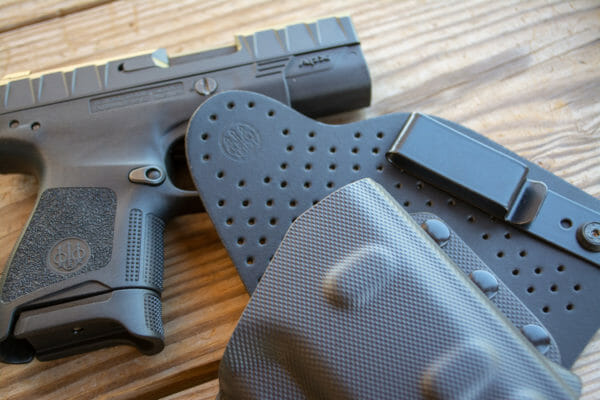
Summer sweaty season is here, and it comes with the want (not necessarily the need) to carry a smaller and more easily concealable pistol. I say “want” because there’s no reason one can’t carry a standard compact or even full-size pistol inside the waistband with nothing more than a tee, polo, or short-sleeved button-down shirt. Yes, the smaller guns are easier to conceal, and no one complains about lugging around less weight.
Anyway, outside of the big vs. small concealment debate, if you’re looking for something more convenient to tote around when wearing shorts and shirts instead of jackets, here are two classic pistols that might fit the bill. They have different design goals, apples and oranges, if you will, so let’s look at where the Beretta APX Carry and Glock 43X fit.
Beretta APX Carry
 The Beretta APX Carry is an interesting addition to the APX family. It shares some of the original compact and full-size model characteristics like grip angle and that nifty ridged slide. Who needs serrations anyway? The full-length approach to slide grip of “building up” ridges about a half inch apart is surprisingly effective.
The Beretta APX Carry is an interesting addition to the APX family. It shares some of the original compact and full-size model characteristics like grip angle and that nifty ridged slide. Who needs serrations anyway? The full-length approach to slide grip of “building up” ridges about a half inch apart is surprisingly effective.
There aren’t sharp edges to wear on hands, holsters, or clothes, but it provides a non-slip grip even with sweaty hands, no matter how you choose to operate the slide. Since the pattern extends the whole length, you can press check, do the pinch-racking method, or the over-the-top whole-hand method. Whichever you choose, you’ll get a positive grip.
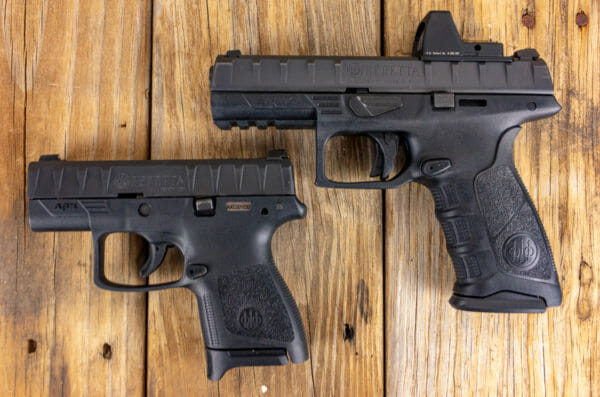
Unlike the larger models, this compact version doesn’t include things like replaceable grip panels or a rail up front for accessory attachment. The sights are a bit different, too. The original larger models came standard with three-dot sights. The APX Carry includes a front white dot paired with a black rear sight. That has fine serrations on the back surface to reduce glare. It’s a good setup for a carry pistol. The sights are mounted in dovetails, so you can swap them out for aftermarket versions of your choice if you like.
What’s different from the original APX pistols is the trigger. And that’s what got me thinking. After I tinkered with the Beretta APX Carry for a while, I wondered if its purpose in life was to be a revolver substitute?
Here’s why.
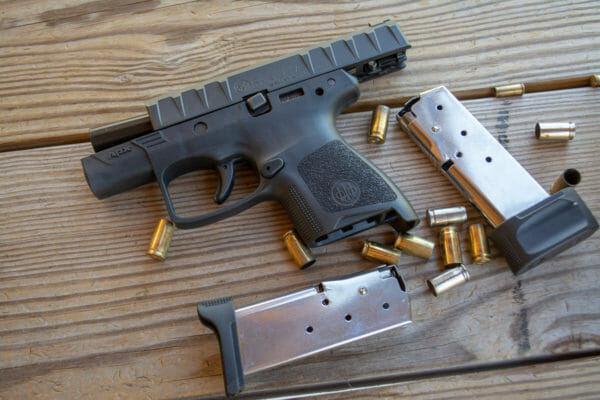
As with its larger siblings, the APX Carry is a striker-fired pistol, but the trigger feels more like a pure double-action. The pull length is about ¾ of an inch, and it breaks with approximately 6 ½ pounds of pressure. The reset is also near ¾ of an inch. That’s very similar to the experience of a double-action snub nose revolver, although at about 60% of the weight.
The APX Carry is also almost identical in size to a snubbie, although given the inherent design differences of a cylinder-fed versus magazine-fed handgun, the shape and placement of bulk vary. But, if you designed a small box just big enough to fit one, the other would drop right in as well.
Since it’s not particularly hard to build a semi-automatic subcompact with a short-travel trigger that breaks in the 5 ½-pound range, I assumed that these attributes were there on purpose. To me, the target market for this subcompact was the pocket revolver crowd. If you feel more confident with that longer trigger press for pocket or deep concealed carry, then the APX Carry might just be for you.
There are advantages over the classic snubbie. While both are workable for pocket carry with the right holster, the APX Carry offers more capacity with a basic capacity of 6 +1. If you use the extended magazine, that gives you 8+1, but of course, the pistol then becomes larger than the snubbie alternative. The next difference is the reloading speed. Sure, revolver speed loaders make a big difference. I’ve been testing a Smith & Wesson 642 Performance Center that’s cut for moon clips, and reloading en masse is much easier, not to mention quicker. But reloading a pre-stuffed magazine will always win the speed contest, at least for me (uhum…Jerry Miculek)
Last but not least is the ease of shooting accurately. Most factory-spec revolver triggers range from 10 to 12 pounds for double-action shots. The APX Carry offers a trigger with just over half that weight, so in theory, it will be easier to manage without pulling the small gun’s sights off target.
While at the NRA Annual Meeting, I cornered one of the Beretta Pistol Product Managers and posed the question, “Who is the APX Carry for? What market are you chasing with it?” His answer wasn’t surprising. He told me that it was for the revolver market. Many people like the peace of mind of that design for concealed carry, and the goal was to offer a semi-automatic alternative with many of the same ‘comfort’ attributes.
Glock 43X
 I shot a Glock, and I liked it.
I shot a Glock, and I liked it.
That’s a big deal for me. Don’t get me wrong; I appreciate Glocks as much as the next guy. I just don’t shoot them as well as other designs. Sure, if I spent most of my range time with Glocks rather than some other brand, I would get perfectly proficient with one without undue stress. And I certainly have no qualms whatsoever about the Glock’s reliability and ability to perform in virtually any conditions. If you handed me one and said, “This is all you get for the rest of your life to protect yourself,” I’d be OK with it, especially if it were one of the Glock Slimline series.

This one works for me because of its arguably near perfect of size and weight and the resulting ergonomic benefits. The 10-round grip is long enough to fit all fingers of my size large hand, and unlike many other Glock models, it’s well-rounded. If you chopped it in half, the circumference would look more like an oblong oval than the traditional blocky rectangle. All of this translates into a soft and comfortable shooting pistol.
With all that said, I’ve been working with/reviewing the Slimline Glock 48 and Glock 43X. As our in-depth reviews on each cover, they’re identical pistols except for barrel and slide length. Out of the box, they’re both great carry pistols. But being a tinkerer, and because I especially liked the carry attributes of the Glock 43X, I decided to buy it. Once I made that mental leap, I had no obstacles to making two customizations to transform it into an even better lightweight carry pistol.
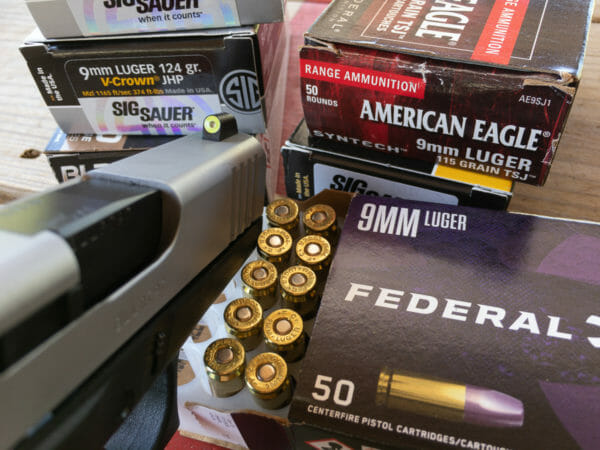
First, I replaced the trigger with an Apex Tactical Enhanced Action Trigger. This minor surgery, while destroying the original trigger body, didn’t touch any of the internal parts like the trigger bar, safety plunger, or connector. It only replaces the trigger body and safety leaf. Even with those seemingly minor adjustments, everything changed for the better. The factory trigger was perfectly reasonable, but I’m a trigger snob, so I wanted to see what could be improved. The net effect of this replacement was a shortening of the travel by about half and a much, much smoother operation. The pull weight remained precisely the same, or as close as my spring scale could detect. That’s expected and by design for this component upgrade. I didn’t want a lighter pull weight for a carry gun, just a better experience.
Next up I upgraded the standard factory three-dot plastic sights. They’re okay, and I’ve never had a problem with the plastic sight housings breaking; I just wanted something more visible. A lot more visible. The XS DXT2 sights for Glock follow the company’s trademark “Big Dot” design but with some modern improvements.
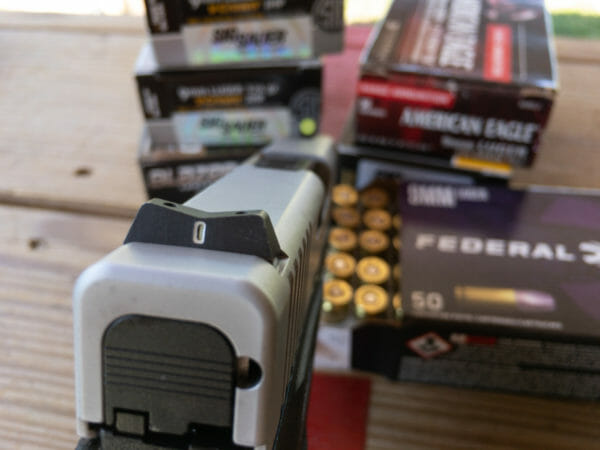
Like the older models, the enlarged front dot includes a Tritium lamp in the center. However, that’s now surrounded by a large photoluminescent ring that picks up ambient light and glows for a while as you transition into darker environments. Imagine going into a house or building or perhaps a darker room. This “mode” provides high visibility for those in between conditions where it’s too dark to see non-illuminated sights easily but not dark enough for the Tritium to glow. These rings are available in both a green and orange version, so you can take your pick. I find the orange more visible in daylight and the green more visible indoors or in the shade.
The rear sight isn’t a notch but rather a shallow “V” like the lever-action sights of old. Operation is simple. Rest the huge ball up front in the “V,” and you’re good to go. The rear also has a Tritium vertical bar rising into the bottom of the “V” for faster and more precise centering of the front sight.
Here’s the bottom line. If your goal is to get 1.25-inch groups instead of 1.5-inch groups, these sights aren’t for you. If your goal is to get groups into a bad guy’s softball-sized cluster as fast as possible, that’s where the DXT2s shine. They’re defensive sights designed to get into your line of vision quickly and allow you to line up your sights on target fast. And they do. You simply can’t miss the enormous front sight as you raise your gun into your line of vision. Setting up targets at 15 yards, I had no trouble shooting orange-sized groups at high speed.
Apples and Oranges
I don’t see these two pistols as directly comparable. Just as you wouldn’t set a bone-in Ribeye steak against Alaskan King Crab legs (the Ribeye is always better!), these ought to be evaluated based on their intended uses. The Beretta APX is smaller, especially in the grip area, and that opens up realistic pocket carry just as one might do with a classic snubbie. The Glock offers a 10-round single-stack magazine, so by necessity, the grip is somewhat taller. Unless you’re talking about a much larger coat or cargo pocket, this pistol will be best suited for waist carry, either on the side or given the short barrel of the 43X, the appendix position.
About
Tom McHale is the author of the Practical Guides book series that guides new and experienced shooters alike in a fun, approachable, and practical way. His books are available in print and eBook format on Amazon. You can also find him on Facebook, Twitter, Instagram, and Pinterest.
